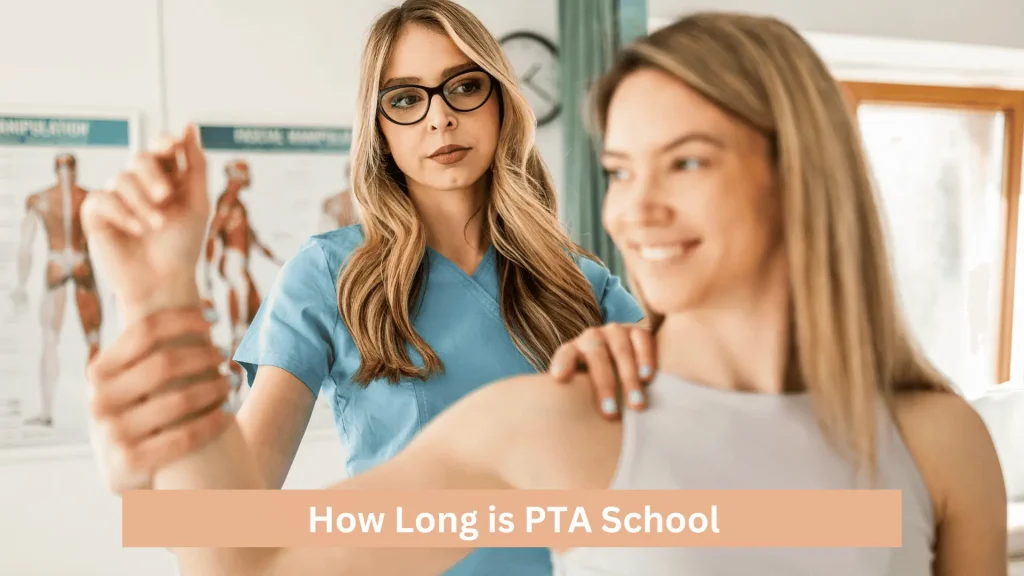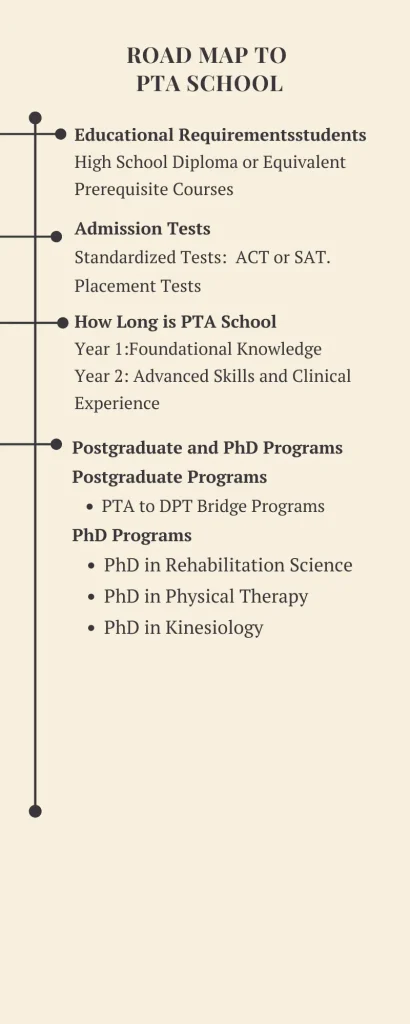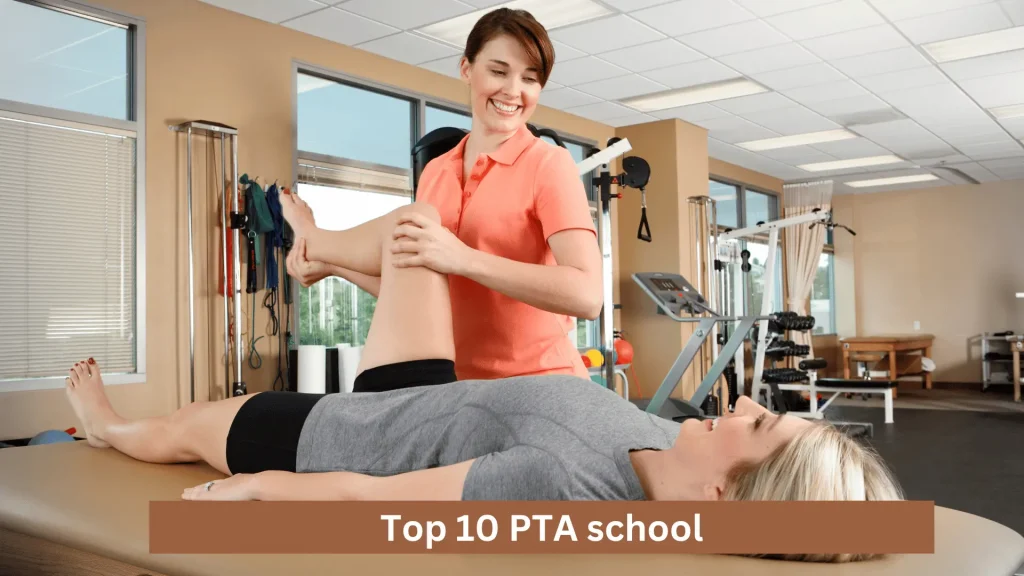How Long is PTA School
How Long is PTA School? Physical Therapist Assistant (PTA) programs typically take about two years to complete. These programs are often offered by community colleges and culminate in an associate degree. In addition to coursework, students must complete clinical internships to gain hands-on experience.
What is PTA School
PTA school prepares students to become Physical Therapist Assistants, who work under the supervision of licensed physical therapists to provide patient care. The curriculum includes courses in anatomy, physiology, kinesiology, and therapeutic exercises. Students also engage in clinical training to apply their knowledge in real-world settings, helping patients recover from injuries and manage chronic conditions.

Graduates of PTA school are equipped with the skills necessary to assist physical therapists in implementing treatment plans, conducting exercises, and utilizing various therapeutic techniques. The goal is to improve patient mobility, reduce pain, and enhance the overall quality of life. Upon completing the program and passing a licensure exam, PTAs can work in various healthcare settings, including hospitals, outpatient clinics, and rehabilitation centers.
How Long is PTA School
Year 1: Foundational Knowledge
Fall Semester:
Introduction to Physical Therapy: Overview of the physical therapy profession, roles, and responsibilities of PTAs.
Anatomy and Physiology I: Study of the human body structure and function.
Medical Terminology: Introduction to the language used in healthcare settings.
General Education Courses: Basic courses like English Composition and Psychology.
Spring Semester:
Anatomy and Physiology II: Continuation of human anatomy and physiology studies.
Kinesiology: Study of human movement and biomechanics.
Therapeutic Exercise I: Introduction to therapeutic exercise techniques and principles.
General Education Courses: Additional courses such as Communication or Sociology.
Year 2: Advanced Skills and Clinical Experience
Fall Semester:
Therapeutic Exercise II: Advanced therapeutic exercise techniques and applications.
Modalities: Study of physical agents and modalities used in therapy, such as heat, cold, and electrotherapy.
Pathophysiology: Understanding diseases and disorders that affect the human body.
Clinical Practicum I: First hands-on clinical experience in a healthcare setting.
Spring Semester:
Rehabilitation Techniques: Specialized techniques for different patient populations, including pediatrics and geriatrics.
Orthopedic and Neurological PT: Focus on treating orthopedic and neurological conditions.
Clinical Practicum II: Extended clinical experience with more responsibilities and patient interaction.
Professional Issues: Ethics, legal issues, and professional development in physical therapy.
By the end of these two years, students will have completed both classroom instruction and practical clinical training, preparing them to take the licensure exam and start their careers as Physical Therapist Assistants.

How to Enter PTA School
Educational Requirements for PTA School
High School Diploma or GED: Most programs require a high school diploma or equivalent.
Prerequisite Courses: Courses in biology, anatomy, physiology, and medical terminology may be required before applying.
GPA Requirements: A minimum GPA, often around 2.5 to 3.0, may be required for admission.
Entry Tests
Standardized Tests: Some programs may require standardized tests such as the ACT or SAT.
Placement Tests: Colleges might require placement tests to assess skills in math, reading, and writing.
Application Process
Application Form: Complete the college’s application form, which can usually be done online.
Transcripts: Submit official transcripts from high school and any previous college coursework.
Letters of Recommendation: Some programs may request letters of recommendation from teachers or employers.
Personal Statement: Write a personal statement or essay outlining your interest in the PTA program and career goals.
Interview: Some programs may require an interview as part of the selection process.
Application Fee: Pay any required application fees, which vary by institution.
Financial Aid
FAFSA: Complete the Free Application for Federal Student Aid (FAFSA) to determine eligibility for federal financial aid, including grants, loans, and work-study programs.
Scholarships: Look for scholarships specific to PTA students offered by the college, professional organizations, or private foundations.
Grants: Explore state and federal grants, such as the Pell Grant, which do not need to be repaid.
Student Loans: Federal student loans, like Direct Subsidized and Unsubsidized Loans, can help cover tuition costs.
Work-Study Programs: Check if the school offers work-study opportunities, allowing you to work part-time to earn money for education expenses.
Tuition Payment Plans: Some colleges offer payment plans that allow you to pay tuition in installments rather than a lump sum.
These steps and resources can help you navigate the process of applying to and funding your education in a PTA program.
Postgraduate and PhD Programs for Physical Therapy Assistants
While Physical Therapist Assistants (PTAs) typically work at the associate degree level, there are opportunities for further education and career advancement through postgraduate programs. These options, while not specific to PTAs, can enhance their knowledge and career prospects within the broader field of physical therapy and healthcare.
Postgraduate Programs
PTA to DPT Bridge Programs: These are designed for PTAs to transition into becoming licensed physical therapists. These programs usually require a bachelor’s degree for entry and then lead into a Doctor of Physical Therapy (DPT) program.
PhD Programs in Physical Therapy
PhD programs in Physical Therapy are research-focused and designed for those interested in academic, clinical, and research positions. These programs are not typically a direct continuation for PTAs but are an advanced option for those pursuing higher education in physical therapy or related fields.
1. PhD in Rehabilitation Science
Focus: Advanced research in physical therapy practices, rehabilitation techniques, and patient outcomes.
Requirements: A master’s degree in physical therapy or a related field. Some programs may accept candidates with a DPT or significant clinical experience.
2. PhD in Physical Therapy
Focus: Developing new knowledge and practices within physical therapy, contributing to academic and clinical advancements.
Requirements: Typically, a DPT or related master’s degree. The program involves advanced coursework, research, and a dissertation.
3. PhD in Kinesiology
Focus: Study of human movement, biomechanics, and the physiological responses to exercise and rehabilitation.
Requirements: A master’s degree in kinesiology, physical therapy, or a related field. Involves extensive research and a dissertation.
Top 10 PTA Schools

1.University of Indianapolis (UIndy)
Offers an Associate of Science in PTA.
Known for its strong clinical affiliations and high pass rates on the National Physical Therapy Exam (NPTE).
2.St. Petersburg College (SPC)
Provides an Associate in Science in PTA.
Offers extensive clinical experiences and has a high job placement rate for graduates.
3.Pennsylvania College of Technology
Offers an Associate of Applied Science in PTA.
Known for its state-of-the-art facilities and hands-on learning opportunities.
4.Salt Lake Community College (SLCC)
Offers an Associate of Applied Science in PTA.
Features a comprehensive curriculum and strong support services for students.
5.Miami Dade College (MDC)
Provides an Associate in Science in PTA.
Renowned for its diverse clinical placements and strong faculty support.
6.Houston Community College (HCC)
Offers an Associate of Applied Science in PTA.
Known for its affordability, diverse student body, and excellent clinical training sites.
7.Green River College
Offers an Associate in Applied Science in PTA.
Features a robust curriculum and strong connections with local healthcare providers.
8.Mount Hood Community College (MHCC)
Provides an Associate of Applied Science in PTA.
Known for its high graduation rates and strong emphasis on clinical education.
9.Lone Star College
Offers an Associate of Applied Science in PTA.
Offers excellent clinical education experiences and high NPTE pass rates.
10.Keiser University
Provides an Associate of Science in PTA.
Known for its small class sizes, personalized instruction, and strong clinical affiliations.
These schools are recognized for their comprehensive PTA programs, which combine classroom instruction with extensive clinical training to prepare students for successful careers as Physical Therapist Assistants. When choosing a PTA program, it’s essential to consider factors such as accreditation, faculty expertise, clinical education opportunities, and support services for students.
Factors Affecting the Length of PTA School
1. Program Type
Full-Time vs. Part-Time: Full-time PTA programs typically take about two years to complete, while part-time programs may extend the duration to three or more years, allowing students to balance other responsibilities.
Accelerated Programs: Some schools offer accelerated programs that can be completed in as little as 18 months, condensing coursework and clinical experiences into a shorter timeframe.
2. Prerequisite Requirements
Completion of Prerequisites: Some PTA programs require students to complete specific prerequisite courses before admission. If these courses are not completed beforehand, they can add extra semesters to the overall program length.
3. Clinical Rotations and Internships
Clinical Placement Availability: The availability and scheduling of clinical rotations can affect program length. If there are delays in securing clinical sites, it may extend the time needed to complete required clinical hours.
Number of Clinical Hours: Different programs may require varying amounts of clinical experience. More extensive clinical requirements can lengthen the program duration.
4. Institutional Schedules
Semester vs. Quarter Systems: Schools operating on a semester system may have different program lengths compared to those on a quarter system, affecting how quickly students can complete the program.
Program Start Dates: Some programs have multiple start dates throughout the year, while others may only start once a year. The availability of start dates can influence the overall timeline for program completion.
5. Student Commitment and Performance
Course Load: The number of courses a student takes per term can impact how quickly they progress through the program. Taking a heavier course load can shorten the time needed to graduate, provided the student can manage the workload.
Academic Performance: Students who fail courses or need to retake exams may face delays in program completion. Maintaining good academic standing is crucial for timely graduation.
6. Transfer Credits
Previous Education: Students with prior college credits or relevant coursework may be able to transfer these credits to the PTA program, potentially reducing the time required to complete the degree.
7. Institutional Factors
Program Structure: Each school designs its PTA program differently, which can affect the length. Some programs may have more intensive coursework or additional requirements that extend the duration.
Resources and Support: Schools that offer robust academic support, such as tutoring and advising, may help students stay on track and graduate on time.
By understanding these factors, prospective PTA students can better plan their educational journey and make informed decisions about which program will best fit their needs and timelines.
Final Verdict
The length of PTA school varies based on program type, prerequisites, clinical rotations, and individual student circumstances. Understanding these factors helps prospective students make informed decisions and plan their educational paths effectively.
FAQs
1.How long does it typically take to complete a PTA program?
Full-time programs usually take about two years, while part-time programs may extend to three years or more.
2.What prerequisites are required for PTA programs?
Common prerequisites include courses in biology, anatomy, physiology, and medical terminology. Requirements vary by program.
3.Are clinical rotations required in PTA programs?
Yes, clinical rotations are mandatory and provide hands-on experience in real-world healthcare settings.
4.Can I transfer credits from previous education to a PTA program?
Many programs accept transfer credits for relevant coursework, which can reduce the time needed to complete the degree.
5.What factors can delay the completion of a PTA program?
Delays can occur due to prerequisite completion, availability of clinical placements, academic performance, and program structure.
